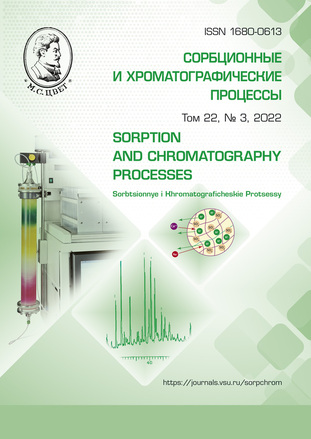Volumetric and refractometric properties of binary solutions of n-propanol and n-alkylethanoates
Abstract
In many cases, the selectivity in chromatography and ion exchange of organic substances is determined by the refractometric and volumetric properties of the solutions. Therefore, it is important to study the patterns of changes in these properties at different temperature, molar weight, and concentration of the components.
In this article, we used binary mixtures composed of the common component, n-propanol, and the first five representatives of the n-alkylethanoate homological series. We studied the dependence of the molar volume and refraction of the solutions on temperature and the molar mass of the second component.
The density isotherms of the two-component solutions showed positive deviations from the additivity rule. Moreover, their value increased with the increase in the molecular weight of n-alkylethanoate in the homologous series. The calculated values of molar volumes for these solutions were linearly related to the molar fraction and molar weight of n-alkylethanoate in the mixture, as well as to the temperature of the system. We provided equations for the calculation of the molar volume of the solutions of the systems with an accuracy of 0.02 cm3/mol in the temperature range of 298.15-338.15K. By correlation analysis, we found that in the case of constant concentration solutions, the molar volume of the mixtures increased additively with the molar weight of n-alkylethanoate and depended linearly on the molar fraction of n-propanol in the mixture. Taking these patterns into account, we proposed a generalising equation normalising the contribution of all the parameters (x, M, T) to the value of Vm.
The refractive index isotherms of the solutions rise gradually with the increase in the concentration and molar weight of n-alkylethanoate in the mixture. The temperature gradient of the solutions is almost independent of the composition and is 0.0003 deg-1. The calculated values of the molar refractions of the solutions increase linearly with an increase in the concentration and molar weight of the ester in the mixture. We obtained the relations of Rm=f(x) for the studied systems and proposed an equation generalising the contribution of the molar fraction and molar weight of the ester to the value of the molar refraction.
The equations proposed in the article make it possible to predict the physical and chemical properties of the solutions in the whole range of concentrations. They can be used to calculate the properties of multicomponent systems for the operational control of aliphatic alcohol and n-alkylethanoate production processes. Moreover, they can be used to determine the selectivity of absorption of mineral and organic raw material molecules and ions by sorbents.
Downloads
References
Lebedev N.N. Chemistry and technology of basic and petrochemical synthesis. M. Chemistry. 1975. 532 p. (In Russ.)
Organicum. Workshop on organic chemistry.Ch. 1 and 2. M. Mir. 1979. 900 p.
Kreshkov A.P. Fundamentals of analytical chemistry. Theoretical foundations. Quantitative analysis. M. Chemistry. 1971. 454 p. (In Russ.)
Zolotov Y.A., Dorokhova E. N., Fadeeva V. I. and others. Fundamentals of analytical chemistry. Book 2. Methods of chemical analysis. M. Higher School. 2004. 503 p. (In Russ.)
National Institute of Standards and Technology (NIST). Search for Species Data by Chemical Formula. Access mode: https://webbook.nist.gov/chemistry/form-ser.html (accessed 20.03.2022)
Suntsov Yu.K., Sorokina Yu.N., Chuikov A.M. Volumetric and refractometric control of the composition of solutions of binary systems of ethanol - n-alkylbutanoates. Problems of ensuring safety during the liquidation of the consequences of emergency situations. 2015; 1: 195-199. (In Russ.)
Magomedov M.M., Suntsov Yu.K., Chuikov A.M. Volumetric and refractometric control of the composition of binary solutions of n-alkylethanoates. Modern technologies for civil defense and emergency response. 2016; 1-2 (7); 376-379. (In Russ.)
Osipov O. A., Minkin V. I., Garnovsky A.D. Handbook of dipole moments. M. Higher School. 1971. 413 p. (In Russ.)
Rudakov O.B., Vostrov I.A., Fedorov S.V., Fillipov A.A., Selemenev V.F., Pridantsev A.A. Satellite of the chromatographer. Methods of liquid chromatography. Voronezh. Aquarius. 2004. 528 p. (In Russ.)
Selemenev V.F., Rudakov O.B., Rudakova L.V., Belanova N.A., Nazarova A.A. Phospholipids against the background of natural matrices. Voronezh. Publishing House - printing center "Scientific Book". 2020. 318 p. (In Russ.)







